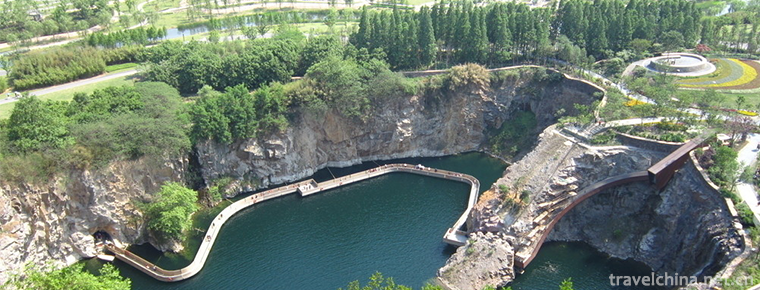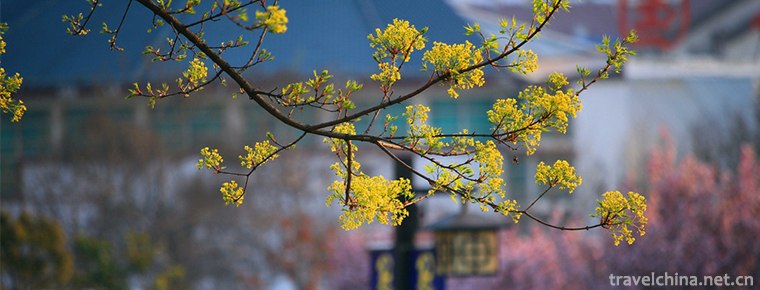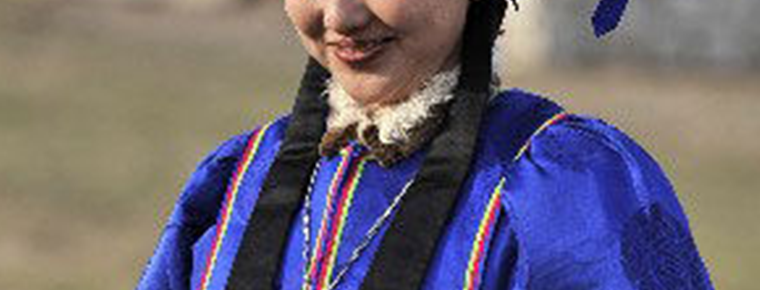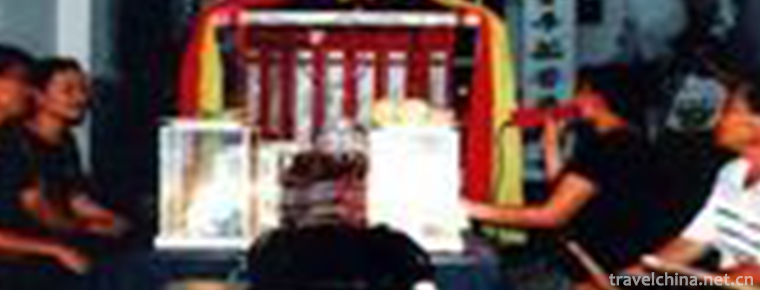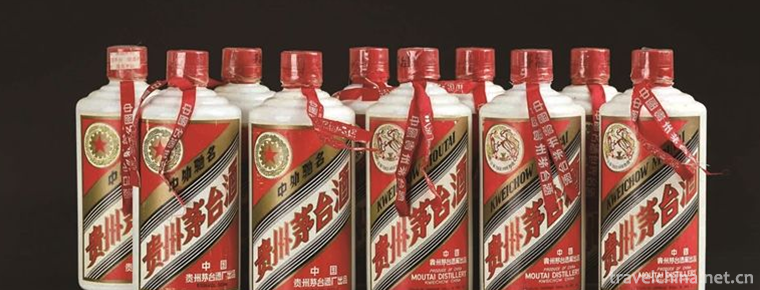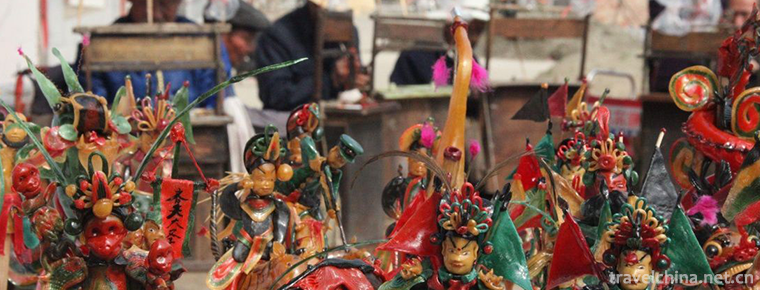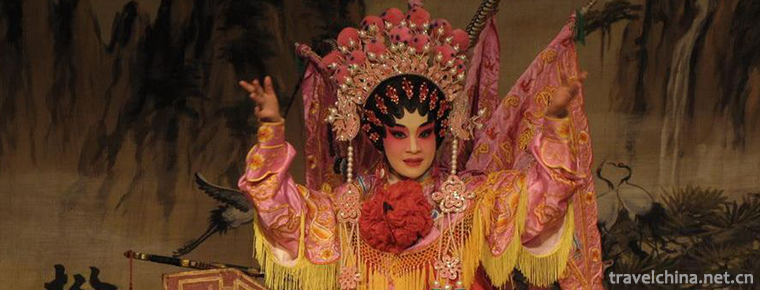Jianhu acrobatics
Jianhu acrobatics
Jianhu acrobatics is a kind of traditional acrobatics art of Han nationality, which originated and spread in Jianhu County, Yancheng City, Jiangsu Province. Historically, the eighteen villages in the eighty-three-mile radius of Qingfeng Town in the county were collectively called "Eighteen Regiments". The acrobatics here has a long history. It is as famous as Wuqiao in Hebei Province and Liaocheng in Shandong Province. It is one of the three birthplaces of Chinese acrobatics. It is well-known both at home and abroad for its unique Han cultural style and exquisite artistic skills. After the 20th century, the famous Jiangsu Acrobatic Troupe and Yancheng Acrobatic Troupe all originated from the Eighteenth Jianhu Troupe. In 2008, it was selected as the second batch of national intangible cultural heritage list.
historical origin
Jianhu County is one of the birthplaces of Chinese acrobatics. Acrobatics here has a long history and a long history. It is as famous as Wuqiao in Hebei Province and Liaocheng in Shandong Province as one of the three birthplaces of Chinese acrobatics. It is well known at home and abroad for its unique Han culture style and exquisite artistic skills.
As early as the 1st and 7th centuries (Han and Tang dynasties), the Eighteen Regiments (eighteen villages within 83-mile radius belonging to Jianhu Qingfeng Township, formerly collectively known as the Eighteen Regiments) were often performed in the music shed of Beijing, sometimes at the court, with good reputation for their skills of antagonizing, narrowing, jumping shot, hunting, walking rope, swallowing knives and spitting fire.
Artistic characteristics
Jianhu acrobatics has gradually formed its unique artistic style in its long-term development process.
Firstly, in the type of program, Jianhu acrobatics mainly focuses on skillful and flexible programs. This kind of program is most suitable for performing on the stage. Its content is also derived from the life of the people in the Yangtze and Huaihe River. It has only been processed and refined by some art. Such as "walking rope", "string reed mat", "throwing ball", "pedaling skills", "hand skills", "drill barrel", "playing flower bed" and so on, all of them are extracted from production and life. Taking Top Bowl and Rolling Cup as examples, Top Bowl was originally a simple imitation of playful young people playing with bowls on their heads after lunch. Now it has developed from one person top to two people top, then to many people top and many people fold Luohan top; the bowl has also developed from one to one stack; not only on the top of the head, but also on the feet, hands and mouth (through instruments). This kind of program originates from life, is close to life, but also needs difficult skills, amazing, popular with the audience, so it can last forever. Up to now, Yancheng Acrobatic Troupe has more than 200 acrobatic and flexible programs, such as "Opponent Top Bowl", "Double Rolling Cup", "Bite Flowers", "Carry Up the Ladder", "Double Pedal Skills".
Secondly, in the performance of the program, pay attention to delicacy and beauty, strive to put high, accurate and dangerous acrobatic movements into a relaxed and fast performance, so that the audience can appreciate the taste of life from the performances of the actors. For example, "Rotary Disk" was originally a simple performance of turntable. Through continuous innovation, it has added beautiful body language such as turning around, lower back, kicking and the thrilling shape of pilohan, which has become a very good program. Another example is "Flying Man in the Air" and "Walking Wire". The action is dangerous, difficult and touching. Nowadays, Dunhuang Flying Sky has been added to the high-altitude action, which makes people refreshed. At the same time, the soft beauty of Southern acrobatics is also appreciated when they are nervous. Again, such programs as "Bite Flowers" can be performed by acrobatics troupes all over the country, but the northern group is strong and strong, while the Yancheng Acrobatics Troupe gives full play to the unique style of the southern group. According to the soft waist and limbs of the performers, dance coaches and stylists design beautiful figures and arrange exquisite shapes. The performers are placed in the light songs and mances, and finally divided into four layers. Bite the flowers and set the frame, showing the beautiful body skills. According to this characteristic, the twelve-person group flexibility program "Spring River Flowers and Moons" was awarded the Silver Lion Prize in the Fourth National Acrobatic Competition in 1995, which is a typical representative work of Southern Acrobatic Art.
Thirdly, in the comprehensive art, we should pay attention to the perfect combination of sound, dance, light and technology, and strive to create a high, new and beautiful artistic realm. Today, with the development of acrobatics, the original hard work, Qigong and various body skills can not meet the audience's viewing needs. Yancheng Acrobatic Troupe attaches great importance to the design and application of clothing and props in the process of learning and innovating programs from brothers such as Guangzhou, Shanghai and Wuhan. It also pays attention to the combination of sound, dance, light and skills to improve the artistry and appreciation of acrobatic programs. For example, "Vehicle Skills" used to be a single-wheeled, double-wheeled, high-speed car performance. Yancheng Acrobatic Troupe, in accordance with the principle of "fantastic design, beautiful clothes, beautiful posture, sound and light change, high skills", re-designed and arranged "Vehicle Skills" carefully, and created "Peacock Opening Screen", a brand-new program. During the performance, more than a dozen actresses, dressed in costumes and feathers, climbed up a speeding bicycle in circles one by one, then, in the climax of accompaniment music, opened their arms at the same time, the sleeves under their arms fluttered in the wind, just like an open-screen peacock, wandering in the ever-changing stage lights. Such programs, due to the combination of sound and light, clothing and props, make the performance of acrobatics and dance more beautiful and colorful, bring the audience a high artistic enjoyment, and thus get the unanimous praise of the audience and experts.
Inheritance situation
In the 14th century (early Ming Dynasty), Zhu Yuanzhang practiced immigration and reclamation. Some acrobats in Suzhou were relocated to the Eighteenth Regiment, together with local acrobats who had been excluded by operas in Beijing, and returned to their hometown to settle down one after another. Since then, the "Eighteen Regiments" has become a place where acrobatics families live, with more than 200 families, including Gao, Wu, Zhou, Xu, Lu, Wan, Xia, Dong, Liao and Zhang, whose surnames are ten, and their people are flourishing and their skills are extraordinary. At that time, they were called "ten acrobatics masters".
Near the Eighteenth Regiment, there are lush pastures and horse ranches in the Huaihe River and the Huaihe River. In Yongle period of Ming Dynasty, ten acrobats bought horses one after another and added new performance items such as horsemanship and animal training. People began to call the acrobatic troupe with horses "circus troupe" or "circus troupe", and those without horses "trick troupe".
In the Qing Dynasty, temple fairs prevailed in northern Jiangsu, and the "Eighteen Regiments" circus troupe was often invited to perform, with increasingly rich projects. Qigong, jacking, pedaling, flying fork, pole, climbing pole, walking rope, lion dance, equestrian, trick (magic) and other skills, not only beautiful image, higher difficulty. During the reign of Kangxu, the Eighteenth Regiment held circus fairs around the Double Ninth Festival every year for half a month. The venue was located at Guji Temple (the junction of today's Qingfeng Town and Jinhu Town). At that time, all the "Eighteen Regiments" artists scattered in the field returned to their places of origin to participate in the "Qunying Xing Meeting", each showing their abilities, with more than 10,000 spectators and unprecedented grandeur. During this period, many acrobats and acrobatics enthusiasts from all over the country came to visit or study. In the mid-Qing Dynasty, the "Eighteen Regiments" circus troupe had developed to about 20 circus troupes, with footprints all over the coastal provinces, and enjoyed a good reputation in most of China.
During the period of the Republic of China, warlords fought in a scuffle, taxed like hairs, and the people were bored. The acrobats of the Eighteenth Regiment were like beggars. Others sail across the sea to make a living in Japan, Singapore, Malaysia and other places.
In the early 1940s, after the establishment of democratic regime in Jianhu area, the "Eighteen Regiments" circus troupe, with the support of the Party and the government, withered in the spring. Most members of the circus troupe were absorbed by the relevant provincial, municipal and military acrobatic troupes. Among some famous acrobatic troupes in the country, there were many "Eighteen Regiments" circus troupe artists. For example, the Gaotongbao family in the late Qing Dynasty was not only famous in China, but also known as "Gaoyibao" when performing in Japan and the Soviet Union. Singapore's famous King's Circus is composed of acrobats from the "Eighteen Regiments" of Jianhu. Dai Wenxia, an actor from Guangzhou Acrobatic Troupe, won the second gold medal in the fifth world Acrobatic Circus competition tomorrow in 1981. Her coach Cui Liangyu is an artist from the 18th Troupe. In the 1950s, acrobatics in Jianhu entered a new period of prosperity, and acrobatics entered the greenhouse from the countryside. In the 1960s, it entered the theatre from the greenhouse, and began to enter the real stage of art from rivers and lakes. At the beginning of the founding of the People's Government of Jianhu County (1954), the scattered acrobats were organized into eight folk art groups, namely Shuangfu, Jianghe, Victory, Xinmin, Victory, Volkswagen, Xinyi and People, to form the "Jianhu County Acrobatic Troupe". In 1959, the "Jianhu County Acrobatic Troupe" was renamed "Yancheng Area Acrobatic Troupe" and later "Yancheng Acrobatic Troupe".
Representative repertoire
Jianhu eighteen regiment inherited the fine tradition of Chinese acrobatics, absorbed the essence of modern dance, artistic gymnastics and other artistic categories, and formed a unique southern style acrobatic style. With exquisite artistic skills, a batch of new acrobatic acrobatics shows were rehearsed. "Opponent Top Bowl", "Double Steel Wire", "Rolling Cup", "Carry Up the Ladder", "High Car Kick Bowl", "Double Flower Bed", "Dunhuang Modeling", "Face Change", "Spring River Flower Moon" and so on are the traditional acrobatics programs of Jianhu Lake. Traditional programs such as "Opponent Top Bowl", "Rolling Ring", "Soft Steel Wire", "Barbie and Toby", "Space Imagination", "Spring Flowers and Autumn Moon" have won awards in East China and China. "Spring River Flower Moon" won the "Silver Lion" prize in the 4th National Acrobatic Competition, and "Soft Gong" won the "Bronze Lion" prize in the 6th National Acrobatic Competition. The film "Opponents Top Bowl" was included in the film "Acrobatic Elite" and screened at home and abroad. Thematic films "New Miaozhuang in Acrobatic Hometown" and "Flowers on Fertile Soil" were broadcast successively in Jiangsu Province and CCTV. He has visited Japan, Canada, Sri Lanka, Bangladesh, Poland, Singapore and other countries for performances and international acrobatic art exchanges, and has hosted performances for officials and entrepreneurs from various countries. In May 2004, the column group "Entering China - Yancheng" of CCTV made a special presentation on acrobatics in Yancheng.
protective measures
At the beginning of the 21st century, "Jianhu Acrobatics" has been listed in Jiangsu Province and China's national intangible cultural heritage protection projects. It has formally entered the list of acrobatics and competitive categories. Yancheng Acrobatics Troupe based on the "Eighteenth Troupe" has improved its office, performance department and training department, with nearly 100 performers and staff, including 16 first and second-level performers and 23 third-level performers. Three life logistics teachers. The training department (i.e. the juvenile team) is an acrobatics troop which mainly improves skills, training and learning, and integrates thrilling, artistic and ornamental performances. It has been highly praised and warmly praised by leaders at all levels, people from all walks of life and foreign friends.
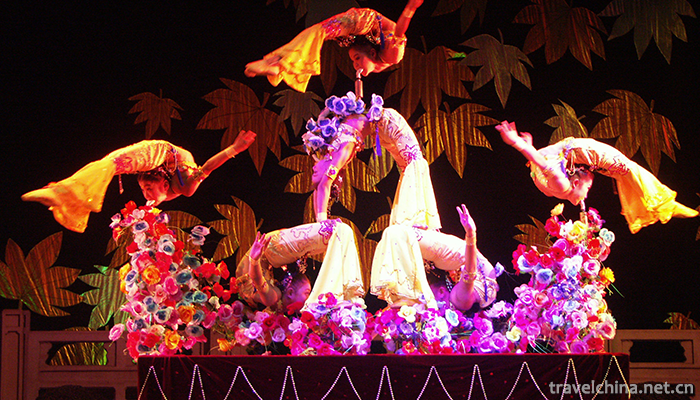
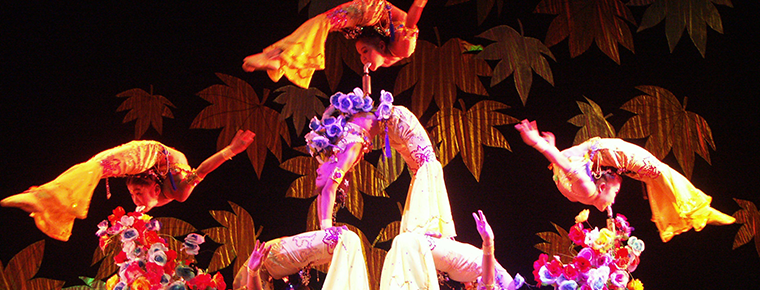
Jianhu acrobatics
-
Shanghai Chen Shan Botanical Garden
Shanghai Chenshan Botanical Garden is located at 3888 Chenhua Highway, Songjiang District, Shanghai. It was opened to the public on January 23, 2011. It was built by Shanghai Municipal Government in c
Views: 188 Time 2018-12-19 -
Caozhou Peony Garden
Caozhou Peony Garden is located in Renmin North Road, Peony District, Heze City, Shandong Province. It is the largest and most diverse peony garden in Heze City.
Views: 200 Time 2019-01-04 -
Guilin Yaoshan Scenic Area
Yaoshan is located in the eastern suburb of Guilin City, 8 kilometers away from the city center. The main peak is 909.3 meters above sea level and 760 meters above sea level. It is the highest peak in
Views: 173 Time 2019-01-13 -
Ewenki costumes
The Ewenki people belong to the Tungusic race, and their clothing materials are mainly animal skins, as do the Tungusic people such as Manchuria and Xibo.
Views: 288 Time 2019-04-28 -
Drum bowl song
Drum-pot song is a very ancient traditional form of music and art in Hubei Province of China. It originates from the traditional folk activities of "beating a pot as a drum, singing with the fune
Views: 108 Time 2019-05-01 -
Brewing Techniques of Maotai Liquor
Maotai liquor brewing technology, the local traditional handicraft technology of Maotai Town, Zunyi City, Guizhou Province, is one of the national intangible cultural heritage.
Views: 201 Time 2019-05-29 -
Pingnanping Opera
Pingnanping opera is a kind of traditional opera with a history of 400 years. As the predecessor of Fujian opera, the main features of the opera are that Taobai singing uses Fuzhou Mandarin, the front
Views: 366 Time 2019-06-09 -
Sugar plastic
Sugar sculpture, one of the traditional folk handicraft products, commonly known as sugar blowing, sugar manikin, engaged in this trade called sugar blowing people, throughout the country, especially
Views: 376 Time 2019-06-18 -
Cantonese opera Yuequ
Cantonese Opera is a popular Cantonese dialect area in Guangdong and Guangxi, and has spread to Hong Kong, Macao, Southeast Asia and the Americas where Cantonese overseas Chinese live. It is a variety
Views: 190 Time 2019-07-16 -
Cheongsam production technology
Most of the classical flag dresses have straight lines. The body is loose and the two sides are split. The bust and waist circumference are close to the size of the dress. The appearance of cheongsam is generally required to have all or part of the following characteristics:
Views: 160 Time 2020-12-11 -
Panzhihuas primary industry
In 2018, the total output value of agriculture, forestry, animal husbandry and fishery in Panzhihua was 7.027 billion yuan, an increase of 4.2%. Among them, agricultural output value was 4.434 billion yuan, an increase of 5.2%; forestry output value was 108 million yuan, an increase
Views: 335 Time 2020-12-14 -
Meishan population
At the end of 2019, the total registered residence population was 3 million 422 thousand and 600, of which 1 million 194 thousand and 900 were urban population. At the end of the year, there were 2.995 million permanent residents, including 1.433 million urban
Views: 363 Time 2020-12-18
